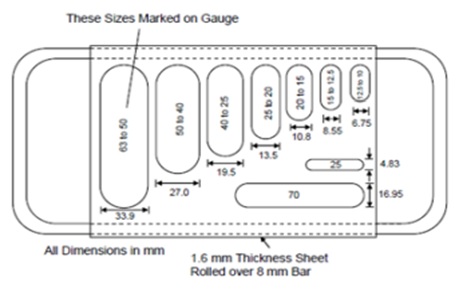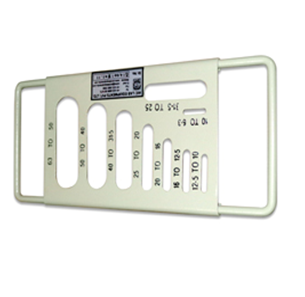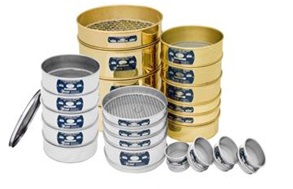AIM OF THE EXPERIMENT:
To determine the Flakiness Index of the given sample of course aggregate.
CODE OF REFERENCE:
• IS 2386(Part 1):1963 Methods of Test for Aggregates of Concrete- Particle Size and Shape. Reaffirmed Dec 2016
• ASTM 4791-10: Standard Test Method for Flat Particles, Elongated Particles or Flat Elongated Particles in Coarse Aggregates, American Society for Testing and Materials.
TEST DESCRIPTION:
Flakiness Index of aggregate is the percentage by weight of aggregate particles whose least dimension is less than 0.6 of their mean dimensions. This test is applicable to aggregates having size larger than 6.3mm.
To calculate the flakiness index of the given sample of aggregates, the weight of each fraction of aggregates passing and retaining on the specified set of sieves is noted first. The pieces of aggregates are made to pass through the slot of specified thickness of gauge and then they are weighed. Then the flakiness index is calculated as the total weight of material passed through various thickness gauges, expressed as a percentage of total weight of the sample gauged.
Flakiness Index = [W2/ W1] x 100
Where, W2= Weight passed from 0.6 x dmean size
W1= Total weight of aggregates
Flakiness Index of aggregates used in road construction should be less than 15% and normally does not exceed 25%.
RELEVANCE AND IMPORTANCE
It is not desirable to use flaky particles in construction of roads especially in surface course. This is because when the load acts along the thin axis (along the axis of minimum moment of inertia) of the flaky flat particles then they may get broken down easily. In order to avoid such condition, the particles have to be tested for their flakiness index values to check their suitability in using for construction of roads. This the reason of the test being carried out.
Table 1: Limits of Flakiness Index for different types of pavements (SOURCE: MORTH)
| Sl No. | Type of Pavement | Maximum limit of flakiness index in % |
| 1 | Bituminous carpet | 30 |
| 2 (i) | Bituminous / Asphaltic concrete | 25 |
| (ii) | Bituminous Penetration Macadam | |
| (iii) | Bituminous Surface Dressing (Single Coat, Double Coat & Precoated) | |
| (iv) | Built up spray grout | |
| 3 (i) | Bituminous Macadam | 15 |
| (ii) | WBM base course and surface course |
APPARATUS REQUIRED:
• A weighing balance having an accuracy in measuring of 0.1% of the weight of sample.
• Metal Gauge: It consists of elongated slots of specified dimensions. The tolerance of dimensions shall be ± 0.2 mm for dimensions equal to or more than 50 mm and ± 0.1 mm for dimensions less than 50 mm.
• Sieves: IS Sieves having sizes as 25 mm, 20 mm, 16 mm, 12.5 mm, 10 mm, 6.3 mm.

Fig 1: Flakiness Index Gauge. COURTESY: IRICEN.GOV.IN

Fig 2: Flakiness Index Metal Gauge. COURTESY: GILSON

Fig 3: Set of Sieves. COURTESY: AIC- LAB EQUIPMENTS
PROCEDURE
1. Given sample of aggregates to be tested is sieved through a set of sieves and separated into specified ranges of size.
2. Minimum 200 pieces of any fraction are taken and weighed properly.
3. In order to separate the flaky materials, the aggregates which pass through appropriate elongated slot of the thickness of gauge are found.
4. The width of appropriate slot would be 0.6 times the average of the range of sizes.
5. The flaky material passing the appropriate slot from each size range of test aggregates are added and then weighed.
6. This weight is then divided by the total weight of sample taken from different range of sizes and the ratio is expressed in percentage which is the desired flakiness index.
OBSERVATION
| Aggregates passing through IS Sieve (mm) | Aggregates retainedon IS Sieve (mm) | Thickness of gauge (0.6 times the mean size of the two sieve sizes) (mm) | Weight of the fraction (g) | Weight of the aggregate in each fraction passing (g) |
| 25 | 20 | 13.5 | ||
| 20 | 16 | 10.8 | ||
| 16 | 12.5 | 8.55 | ||
| 12.5 | 10 | 6.75 | ||
| 10 | 6.3 | 4.89 | ||
| TOTAL | W= | w= | ||
CALCULATION
Total weight of the fraction, W=
Total weight of passing fraction, w=
Therefore, Flakiness Index= [w/W] x 100%
PRECAUTIONS
• Safety shoes must be used along with masks and aprons at the time of test.
• Gauge should be cleaned thoroughly and dried before testing.
• Special care must be taken that no outer air enters when using the balance.
• All parts of equipment should be kept clean.
• After the end of test, sieve should be cleaned by smooth brush.
from Civil Engineering Portal https://ift.tt/2ACXNXx


